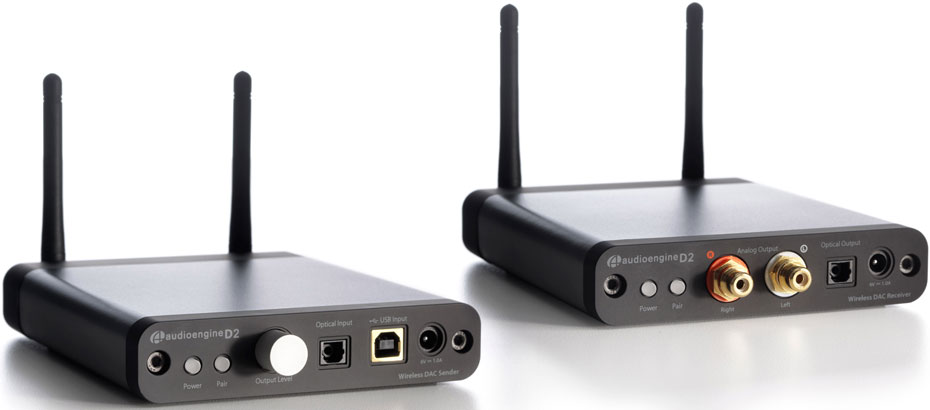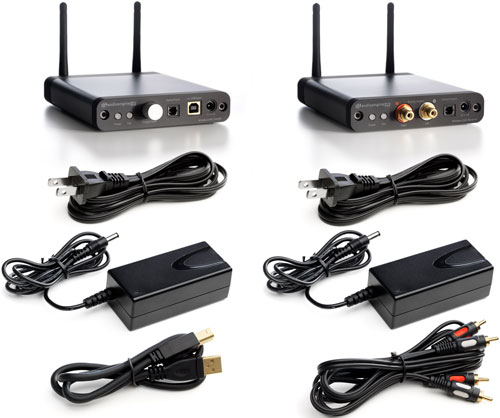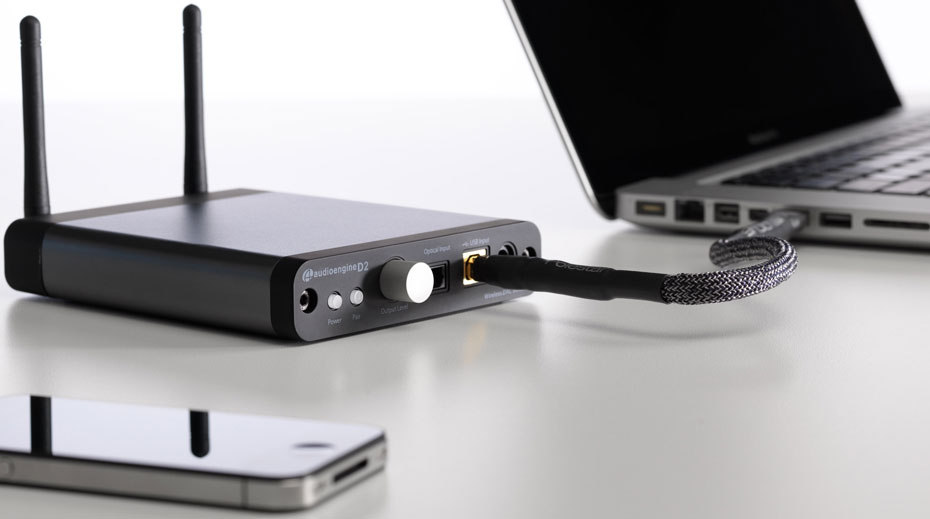The crowded world of digital audio is awash with many interesting products, with a market lifespan only slightly longer than the average laptop/pad/widget. Being a Luddite, I ignore digital products as “lifestyle” oriented, rather than true high end components, so I am not an expert on things digital. What I do know is that most high-end audio products have been tweaky, difficult to set up, didn’t sound good with every source and were quickly superseded by a new product with a better “chip,” better “architecture,” or a Chinese copy that does the same thing for ¼ the price. Needless to say, with an attitude like mine, I’ve spent virtually no money or time on digital audio.
So, is there anything wrong with a “lifestyle” audio product? A few years ago, I would have said “yeah, total shit and not worth considering,” but with the avalanche of interesting programming by way of YouTube, internet radio and “high quality MP3,” my attitude has taken a 180. Once upon a time you had to go out of your way to hear new music, or risk wasting $20 on a record or CD that might be total garbage, subjectively. With the changes in music distribution, easy access to high speed internet and proliferation of streaming content, there are only two types of products that really make sense: a self-built dedicated music/media server, or a quality USB DAC, fed by output of your various digital devices. The Audioengine D2 falls into the second group.
Skill Saw
Explaining it very basically, the D2 is a USB DAC that has been cut in half, then a wireless LAN has been inserted between the digital input section and the DAC. The result is a “sender” that locks onto digital signals, then beams them wirelessly over a LAN to a “receiver” that does the actual digital-to-analog conversion. The sender box connects via USB or Toslink, with the USB connection supplying power for use with computers. For use with the Toslink connection, a supplied high quality power supply provides juice. Either way, the sender/input unit has multiple stages of power supply regulation to prevent noise from finding its way into the unit and causing digital mayhem.
The sender unit has a volume control which uses a separate LAN channel to control the output level of the receiver unit’s analog section. This is perhaps the best feature of the D2. Controlling volume at the analog output section is better than the digital alternative. What this means is that if you are using a computer exclusively for your source, you can connect the D2 receiver unit directly to your power amp and use the sender unit’s volume control to set volume. This is much better than using a preamp or integrated amp’s volume control to set gain at some guesstimated level, then using your computer’s built-in volume control to adjust volume in the digital domain. Just crank your computer’s volume all the way up for best resolution, then use the volume control on the sender unit to adjust system volume. Seems like a great solution to me.
The receiver/output box is powered by its own power supply and though not stated in the literature, I believe the receiver unit has several stages of power supply regulation. That is my assumption based on the exceedingly low noise levels of the D2 pair.
Besides the usual analog outputs, the receiver unit has an optical output, making the D2 a USB-to-SPDIF converter. I guess that’s important for some people, but I never used this feature.
Now, for Audioengine’s marketing spiel:
Advantages of wireless
The D2 wireless system transmits bit-perfect PCM-stereo simultaneously to up to 3 receivers. This PCM stream is routed from/to the various components of the system (optical transmitter/receiver, USB controller, and DAC) via the I2S bus, which maintains data integrity throughout the system. Because the various source/sink components are segregated by the wireless subsystem, various anomalies which plague many wired DACs such as jitter, grounding, and induced cable noise are greatly reduced. In addition, the D2 allows the user to physically isolate a potentially noisy computer from the sensitive audio components in your system.
D2 USB
The D2 utilizes the TI1020B USB controller chip, widely recognized as the industry standard for higher-end USB audio products. The Sender can be powered directly from the USB bus or from the included external power adapter. The USB power is passed through two stages of regulation to ensure high stability and low noise.
D2 DAC
The D2 Receiver utilizes the PCM1792 DAC, widely know for it’s low noise and high fidelity. Due to the PCM1792’s high signal-to-noise specs and the added benefit of triple redundancy power source conversion and filtering, the D2 presents impressive low noise and low distortion characteristics.
I2C Volume Control
The D2 incorporates a separate-path wireless channel to transmit volume information from the Sender volume control to the analog section of the Receiver. This means that the volume information never affects the digital audio stream.
D2 and LAN
The D2 system divides the band between 2405 MHz and 2477 MHz into 37 discrete, 2 MHz wide channels. Channels numbered 2 through 38 inclusive are used for system operation. The system scans the spectrum and selects two channels that are 18 channels (or 36 mHz) apart and transmits with 50% of the time on one channel (for example channel 2) and 50% on the other channel (for example channel 20). The system stays on these selected channels until the error detection rate reaches a pre-determined level indicating deteriorating RF conditions. The system will then select a cleaner channel for transmission and move there without any drop in audio. In this way the D2 not only maintains it’s own audio integrity, but co-exists nicely with other LAN devices.
Putting it Back Together
The first thing you’ll notice about the D2 is the high quality of its connectors, jacks, hardware and cases. For budget componentry, it’s all well done, though not over the top (no 1” thick face plates). Packaging was well done, with units coming in little microfiber bags to prevent scuffing and scratching.
Getting the D2 running proved simple; it’s plug-and-play. It wasn’t necessary to download software, reconfigure my computers, turn things on and off, etc. Plug the sending unit in to the computer’s USB port, plug the receiver’s RCA jacks into your system, power up, and start playing music. The two boxes automatically found each other, so there was no need to pair them.
Audioengine does talk about a break-in period, but in my experience it takes several weeks more than what is recommended. Plug the D2 into the toslink output of Satellite tuner (both my Direct TV tuner and HDTV set has toslink outputs), and leave the D2 powered up for several weeks before serious listening.
Perhaps the biggest improvement over using a sound card is the total absence of noise. I didn’t even notice it at first. What I did notice, when listening to low bit-rate junk off YouTube, is a darkness to the sound I hadn’t heard before. At first, I thought the D2 was artificially stripping out the highs to make the sound more palatable. But that’s not what was going on. I had always associated low quality streaming audio with harshness and brightness. What the D2 did was remove the high frequency noise that exists in the computer, then more gracefully decode the compressed audio. So, the low bit rate stuff wasn’t harsh and bright, after all. Instead, it was muffled and dead because the mp3 process was eliminating massive amounts of high frequency information. (MP3 to CD compression ratio can be 1:10. -Pub.)
So how did mp3 audio sound? Not spectacular, but only a divine miracle could reverse the damage, turning water into wine. The D2 does give you higher quality from an mp3 than any other USB DAC I’ve heard, and that’s a major accomplishment. A full-on miracle would give you 10 lbs from a 5 lb sack. What the D2 does is give you 7.5lbs from a 5lb sack. For some tracks you could be fooled into thinking the mp3 was much better than it really was. The illusion fell apart when the occasional cymbal suddenly exploded out of the mix, sounding like compressed air instead of bronze. That’s not the fault of the D2. Mp3 tracks absolutely destroy the sound of cymbals and high strings. And barring a divine intervention, it’s not going to sound any better.
With higher quality mp3 files, the sound was much better. Highs were much smoother and occasionally the results were “CD quality.” The biggest difference between the higher rate mp3 and 16/44 was image depth. The D2, through no fault of its own, will sound two-dimensional on virtually all compressed audio. Even extremely expensive high end DACs have problems extracting image depth from compact disks, so the D2 isn’t deficient in the area. It is what it is, and outside of a few very well produced compact disks, two-dimensionality is the hallmark of low quality digital source material.
Where the D2 does shine, is with high quality digital files, produced not to be a commodity, but to sound good. I have numerous digital downloads from LP purchases (“this LP comes with a free digital download of the album”). When the file had sufficient information, the D2 produced good image depth, width and high frequencies relatively absent of aliasing and error.
The big question for me, coming into this review, was how it would compare to other USB DACs. Well, it pretty much destroys the majority of what I’ve heard at shows and in other systems. I’ve avoided USB DACs like a suicide bomber with leprosy. The proliferation of these awful sounding devices at high end audio shows is one of the reasons I avoid audio shows. Out of convenience, exhibitors bring along their lap top, loaded with hours of good music, then connect a flakey USB DAC. The results are sometimes horrible, and almost universally mediocre. The D2 manages to improve USB DAC performance, especially when playing back low quality files, to a higher level compared to most competing products.
S/PDIF
The D2 does allow you to use it as a traditional DAC with a Toslink S/PDIF input. This is my only real complaint about the unit. Toslink sucks. I’d much prefer the inclusion of a SPDIF RCA jack. Most decent consumer grade digital transports offer both coaxial and toslink SPDIF connections, and the coaxial usually sounds better. Still, when using the toslink connection of the D2, the sound of my cheap Pioneer universal player was significantly better than using the Pioneer’s internal DAC. The only area in which the Pioneer seemed to have an edge was in low bass reproduction. But the difference in bass reproduction was small, and will probably be inaudible in most systems (my transmission lines can go very deep). The D2 had much lower distortion and significantly more information than the Pioneer.
Open Ended
In my current system, comprising the new Raven Audio integrated amp (review forthcoming) and GR Research Alpha LS speakers, the overall sound is very good, though not quite high-end. On the positive side, information retrieval is excellent and distortion is extremely low. On the other hand, the combination pushes images too far forward, which is the fault of all three components (speakers, amp and D2). All three are slightly forward sounding, and the resulting images are almost always in front of the speakers.
It took a lot longer than normal to come to any conclusions on the D2 because I lack the software needed to test its limits; I am the digital Luddite at Dagogo. I plan on getting my hands on some high quality 24 bit downloads and plugging the D2 directly into my newly purchased Sanders Magetch amp, which will be very instructive. Accordingly, I will report back when I have had a chance to experiment with better source material. Consider this review open ended, then.
What I do know about the D2 is this: It makes the most of MP3s and streaming music. It is significantly quieter than the other USB DACs I have heard, which is a design goal of Audioengine. In that regard, the D2 is a total success. Regardless of source quality, I haven’t heard a quieter or lower distortion USB DAC. I am not an authority on USB DACs, but I know what I’ve heard in other settings. The D2 delivers high quality sound from low quality files, making casual listening a reality. That’s exciting news for those who surf the web for new music. If your experience with USB DACs mirrors my own, the D2 is a safe bet. Considering the low price, ease of use, and high quality, the D2 is an easy recommendation.
- (Page 1 of 1)




did you ever experiment with high res files e.g. 24/96?
Michael,
Unfortunately no. I am a cheapskate when it comes to computers and I needed to upgrade. I’m looking at a Mac Mini based system. Analog is more my thing because I’m a record collector. Still, the latest digital is producing sound better than analog in some ways. It depends on the recording and mastering engineer. Well mastered 45 rpm is still champ.
Micahael, I have a cheap $189.95 HP Chrome book that uses the Chrome Operating System. From it I extract Rhapsody’s offering of over 30,000 CD albums. Many of these albums are of high end audio quality and for ten bucks per month for unlimited use of these albums, a steal.
Rhapsody’s service is transmitted from my little HP Chrome Book to a Chrome HDMI plug in device ($34.95) which plus directly into the HDMI input on the front (or back) of my OPPO BDP 105D CD/DVD/Blue Ray DVD, player which I also use as a stereo and surround sound preamp-processor. Into this player is plugged a LAN set up . Said transmission received by said Chrome HDMI plug in device, when played through the OPPO’s Sabre DtoA converter chips puts out a superior, super clean and flat musical reproduction through my custom built speaker system. Quite amazing for less than thirty-five bucks to realize a high-end, “state-of-the-art” … you are there musical experience.
It’s clear that during the past four years since you wrote your article on the Audio Engine D2, digital transmission and reception has come a long-long ways.
In summary, this low cost, Chrome widget, when plugged into an HDMI input of a decent preamp or prepro that features a built in “state-of-the-art” digital to audio converter will reward the listener with an extremely live, flat, distortion free, you are there sound fully equal to playing the CD itself. This, of course, is provided the recording transmitted by Rhapsody to one’s computer via LAN, and that computer is using the Chrome Operating System and the recording received from Rhapsody is a state-of-the-art, high rez digital recording.
Great article, Highly enjoyed it.
Dr. Robert Dean